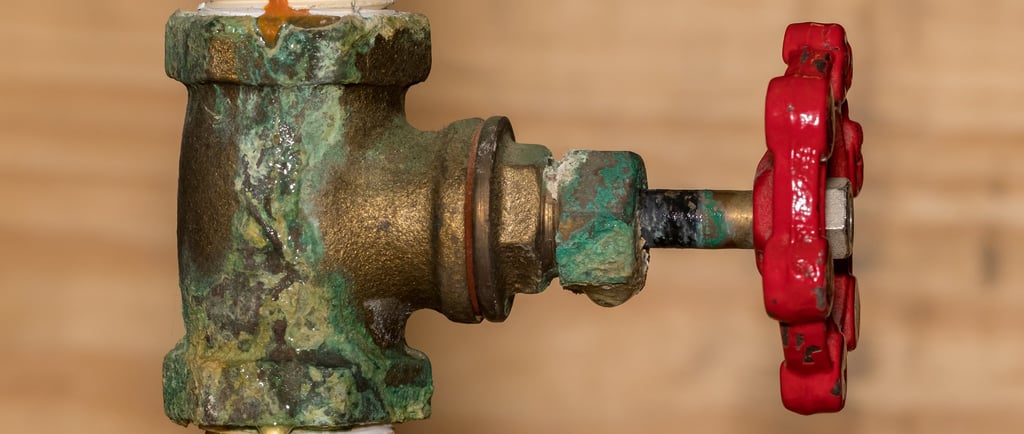Water Shutoff Valve FAQ: Knowing This Could Save Your Home and Wallet
EMERGENCY PLUMBINGPREVENTIVE PLUMBING TIPSRESIDENTIAL PLUMBINGFAQSCOST-SAVING PLUMBING TIPS
2/26/20254 min read


When it comes to plumbing emergencies, seconds count. Whether it’s a burst pipe, an overflowing appliance, or a sudden leak, knowing how to quickly shut off your home’s water supply can prevent extensive damage and costly repairs. In this FAQ, we’ll cover everything you need to know about your water shutoff valve, so you’re ready to act when it matters most.
What Is a Water Shutoff Valve?
A water shutoff valve is a device that controls the flow of water into your home. Turning this valve off stops the flow of water from your main supply line, allowing you to address plumbing issues without additional water damage.
There are typically two types of water shutoff valves:
Main Shutoff Valve: Controls water supply for the entire home.
Fixture-Specific Shutoff Valve: Located near individual fixtures, such as sinks, toilets, and appliances, these valves control water flow to a specific fixture.
Why Is the Water Shutoff Valve Important?
The water shutoff valve is your first line of defense against water damage. Shutting off the water supply can help in the following ways:
Preventing flooding and damage to your home.
Saving money on water bills caused by undetected leaks.
Providing time to fix plumbing issues safely and effectively.
How Do I Find My Main Water Shutoff Valve?
Locating your main water shutoff valve is critical. In most homes, you can find it in one of these common places:
Basement Room Access Door: On the street side of a basement wall, in an access box or closet. In our experience, this is the most common place for homes in the Salt Lake area.
Crawl Space: Near the point where the main water line enters your home.
Utility Room: Close to your water heater or near your furnace.
If you’re having trouble locating the valve, check your home inspection report or consult a plumber.
How Do I Operate the Shutoff Valve?
Most shutoff valves are simple to operate. They typically come in two main types:
Gate Valves: Turn the wheel or knob clockwise to close the valve (righty-tighty) and counterclockwise to open it (lefty-loosey).
Ball Valves: These valves have a lever handle. Turn the lever so it’s perpendicular to the pipe to shut off the water. Turn it parallel to the pipe to restore flow.
Practice turning off your valve so you’re familiar with its operation in an emergency.
What Should I Do if My Shutoff Valve Is Stuck?
Over time, shutoff valves can become stuck due to corrosion or lack of use. If you’re unable to turn the valve, do this:
Apply Gentle Pressure: Use a wrench or pliers for extra leverage, but be careful not to force it and risk breaking the valve.
Lubricate: Apply a penetrating oil like WD-40 to loosen the mechanism.
Call a Professional: If the valve won’t budge or you suspect damage, contact a plumber for assistance.
Can I Test My Water Shutoff Valve?
Yes, and you should! Regularly testing your shutoff valve ensures it’s in good working condition. Here’s how:
Turn off the valve.
Check to see if water stops flowing from your fixtures.
Turn the valve back on and confirm that water flow is restored.
Testing your valve every six months or during routine plumbing inspections can help prevent surprises during emergencies.
What If I Don’t Have a Main Water Shutoff Valve?
In rare cases, older homes may not have a main shutoff valve. If that’s the case, you’ll need to take these steps:
Locate the municipal shutoff point at your water meter.
Use a water meter key or wrench to turn off the supply.
Consider hiring a plumber to install a main shutoff valve for added convenience and safety.
Should I Replace My Shutoff Valve?
Shutoff valves don’t last forever. Signs that your valve may need replacement include the following:
Difficulty turning the valve.
Visible corrosion or rust.
Leaks around the valve.
Replacing an outdated or malfunctioning valve can save you trouble in the long run and ensure you’re prepared for emergencies.
How Do Fixture-Specific Shutoff Valves Work?
Fixture-specific valves are typically located under sinks, behind toilets, or near appliances like washing machines. These valves allow you to isolate water flow to a specific fixture without shutting off the supply to your entire home. To operate these valves, turn them clockwise to stop water flow and counterclockwise to restore it.
What Are Some Tips for Maintaining My Shutoff Valve?
Make sure you keep your shutoff valve in good condition:
Test It Regularly: Turn the valve on and off every few months to prevent sticking.
Keep It Accessible: Avoid covering or obstructing the valve with furniture or storage items.
Address Leaks Promptly: A leaking shutoff valve should be repaired or replaced immediately to avoid further damage.
What Should I Do in an Emergency?
If you experience a plumbing emergency, follow these steps:
Locate and turn off your main water shutoff valve.
Open nearby faucets to relieve pressure and drain excess water.
Contact a plumber to diagnose and repair the issue.
Having a plan and knowing the location of your shutoff valve can make all the difference during a crisis.
Final Thoughts
Understanding how to locate, operate, and maintain your water shutoff valve is a small but crucial step in protecting your home from water damage. By staying proactive and prepared, you can save yourself time, money, and stress—all while keeping your plumbing system in top shape.
Contact
Main Office
Social
3560 S 2200 W
West Valley City, UT 84119
P.O. Box 25123
Salt Lake City, UT 84125
Monday – Friday:
7:00 am – 3:30 pm
Billing & Mailing Address
Hours
© Budd M. Rich Plumbing Company, DBA BRPI Mechanical. All rights reserved.
